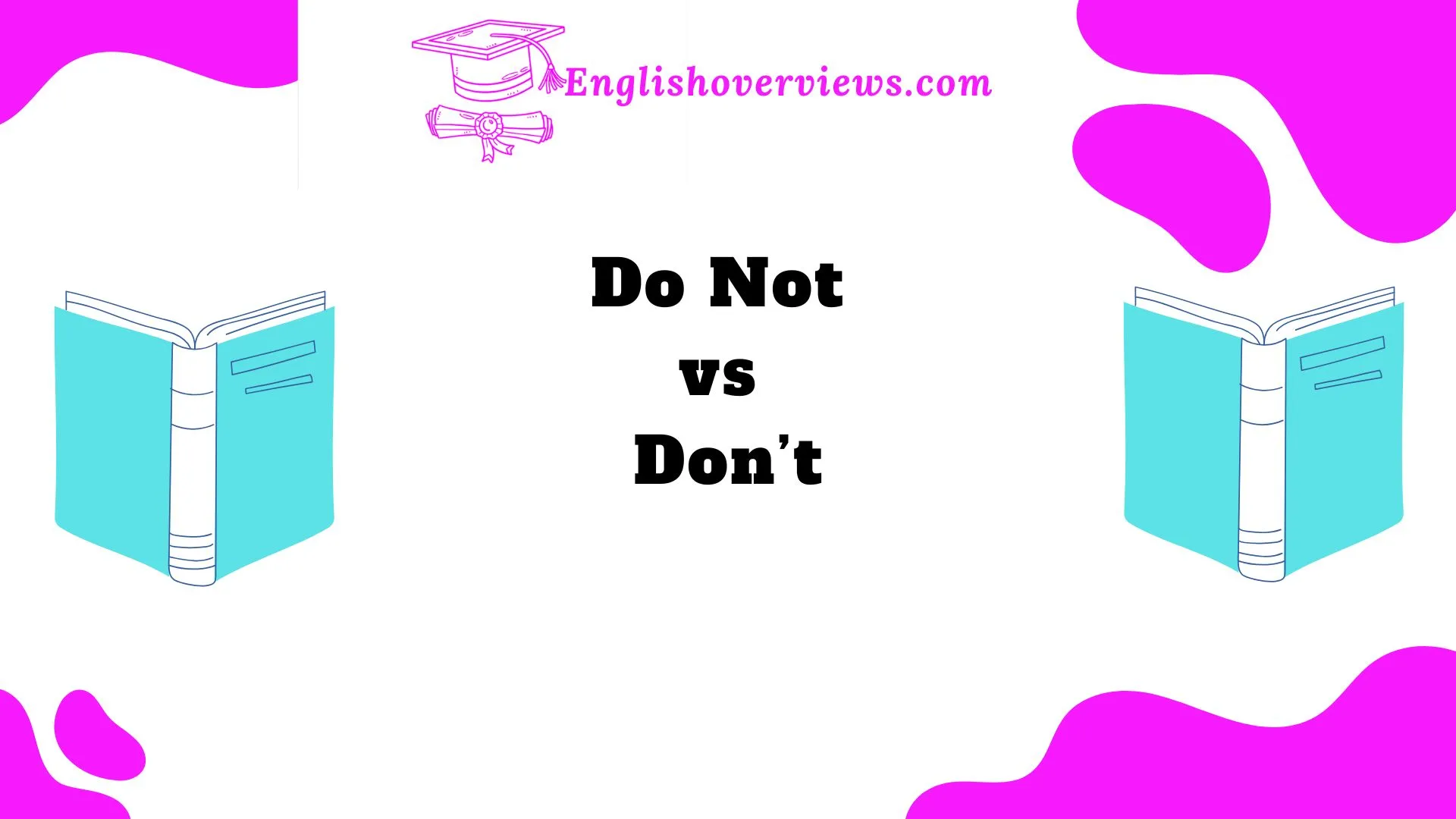The English language is full of nuances, and one of the most common confusions people face is when to use “do not” versus “don’t”. While they may seem interchangeable, these two forms have distinct implications, especially when it comes to tone, formality, and context.
In this article, we’ll break down the differences between “do not” and “don’t”, explore when it’s appropriate to use each one, and provide examples to help you master these expressions.
Whether you’re writing a professional email, drafting an essay, or simply having a casual conversation, knowing when to use “do not” and when to opt for “don’t” can make a big difference in how your message is received.
Let’s dive into the rules, real-world examples, and tips to clear up any confusion.
The Basics of ‘Do Not’ vs. ‘Don’t’
At its core, the difference between “do not” and “don’t” is straightforward: “do not” is the full, formal version, while “don’t” is the contracted, informal version. But why should you care about this distinction? The way you choose between these two options can have an impact on the tone and formality of your communication.
Here’s a simple breakdown of the two:
| Form | Usage | Example |
| Do Not | Full form, more formal or emphatic | “I do not understand the question.” |
| Don’t | Contraction, informal, used in everyday speech | “I don’t understand the question.” |
Both are grammatically correct, but understanding when to use which one can significantly improve the clarity and tone of your writing.
Why Does This Matter?
The formality of your writing or speech plays a key role in deciding between “do not” and “don’t”. While “don’t” may sound more relaxed, “do not” can be more appropriate in professional, academic, or official settings.
For example:
- Formal: “Please do not hesitate to reach out if you need assistance.”
- Informal: “Don’t hesitate to reach out if you need help.”
Formality in Language: Choosing Between ‘Do Not’ and ‘Don’t’
The choice between “do not” and “don’t” often comes down to the level of formality required. Let’s break it down:
When to Use ‘Do Not’
- In Professional Emails: When writing formal emails, especially in business settings, it’s best to use “do not” to maintain professionalism.
Example: “We do not accept returns after 30 days.” - In Academic Writing: Academic papers, essays, or other scholarly works typically require more formal language, so you should use “do not” unless the style guide specifies otherwise.
Example: “Researchers do not agree on the causes of climate change.” - In Legal or Instructional Writing: Contracts, legal agreements, and instructions often call for “do not” to ensure clarity and avoid ambiguity.
Example: “You do not have permission to share this document.”
When to Use ‘Don’t’
- In Casual Conversations: “Don’t” is perfectly fine in everyday speech and writing. It sounds natural and conversational.
Example: “I don’t want to go to the movies tonight.” - In Informal Writing: If you’re writing a blog post, social media post, or a personal email, “don’t” helps create a more approachable tone.
Example: “Don’t forget to check out our new product launch!” - In Friendly Correspondence: Whether you’re sending a friendly reminder or communicating with a colleague you know well, “don’t” is a great choice.
Example: “Don’t worry about the deadline—we’ve got this covered.”
Summary of Formal vs. Informal Use
| Context | Do Not | Don’t |
| Formal Writing | Preferred | Less common |
| Casual Conversations | Rarely used | Commonly used |
| Professional Emails | Preferred | Used in some cases |
| Academic Writing | Required | Rarely used |
| Instructions | Often required | Rarely used |
The Role of Tone in Speech and Writing
The tone of your writing can dramatically shift based on whether you use “do not” or “don’t”. Let’s take a look at how these subtle differences impact communication.
Formal Tone with ‘Do Not’
When you use “do not”, the tone comes across as more serious and authoritative. It’s the choice for instances where you need to convey a sense of professionalism or urgency.
Example:
- Do not touch the exhibit. (formal and instructive)
Casual Tone with ‘Don’t’
On the other hand, “don’t” creates a more relaxed and friendly tone, which is great for informal conversations. It helps break down barriers, making the message feel less rigid.
Example:
- Don’t worry about being late; we’ll wait for you. (informal and comforting)
Grammatical Rules: When to Use ‘Do Not’ vs. ‘Don’t’
Both “do not” and “don’t” are grammatically correct, but understanding the structure of your sentence is key to making the right choice.
Subject-Verb Agreement
Both forms follow the same subject-verb structure. Here’s how they work:
- Do not + [subject] + verb (more formal)
Example: “You do not need to bring your own equipment.” - Don’t + [subject] + verb (more casual)
Example: “They don’t need to bring their own equipment.”
Using ‘Do Not’ for Emphasis
In more formal contexts, you might choose “do not” to add emphasis to your statement.
Example:
- “I do not appreciate being ignored during meetings.”
Using ‘Don’t’ in Direct Speech
“Don’t” often sounds more natural in direct, conversational speech.
Example:
- “I don’t understand what you mean by that.”
Pronouns and Their Influence on Usage
The choice of pronoun can affect whether you should use “do not” or “don’t”. Here’s how it breaks down:
First and Second Person Pronouns
- First Person: “I” or “we” often use “don’t” in everyday speech.
Example: “I don’t like coffee.” - Second Person: “You” can also go with “don’t” in informal settings.
Example: “You don’t need to explain yourself.”
Third Person Singular and Plural
For third-person subjects, “do not” is sometimes used for emphasis, but “don’t” is still grammatically acceptable.
- Third Person Singular:
Example: “He does not want to join the meeting.” - Third Person Plural:
Example: “They don’t need any help.”
Misconceptions and Common Errors
There are a few common mistakes that people make when using “do not” and “don’t”:
- Overuse of ‘Do Not’ in Casual Conversations: Some may mistakenly think “do not” sounds more “correct” in any context, but it’s important to balance formality and naturalness.
Example: “Don’t forget to call me” is much more natural than “Do not forget to call me.” - Underuse of ‘Do Not’ in Formal Writing: On the flip side, some may overuse “don’t” in formal settings when “do not” is more appropriate.
Real-World Examples
Let’s put this all into perspective with a few real-world examples to highlight the practical application of “do not” vs. “don’t”:
Business Email:
- Do not: “Please do not hesitate to contact me should you have any questions.”
- Don’t: “I don’t think we can afford that option at the moment.”
Text Message:
- Do not: (Rarely used here) “You do not need to reply right away.”
- Don’t: “I don’t feel like going out tonight.”
Legal Document:
- Do not: “You do not have permission to use this material without consent.”
FAQs About ‘Do Not’ vs. ‘Don’t’
- Can I always use ‘don’t’ instead of ‘do not’?
- While “don’t” is acceptable in most informal contexts, you should opt for “do not” in formal writing or when you need to be emphatic.
- Is ‘don’t’ less correct than ‘do not’?
- No, “don’t” is perfectly correct in casual settings. The key is knowing when formality matters.
- Does the choice between ‘do not’ and ‘don’t’ change with the subject?
- No, both forms are used with any subject, but you’ll find “do not” more often in third-person singular forms for emphasis.
Conclusion: Mastering the Art of ‘Do Not’ and ‘Don’t’
Now that you know the difference between “do not” and “don’t”, you can confidently use each one based on the context, tone, and formality of your communication.
Whether you’re drafting a formal email, texting a friend, or writing an academic paper, the right choice of words can make a huge impact.
Keep in mind that “do not” is often the safe bet for formal or professional writing, while “don’t” works perfectly for most casual conversations.
By following these guidelines, you’ll avoid common errors and elevate your communication, sounding both polished and approachable.

English Overviews is a resourceful website dedicated to providing valuable content related to grammar and vocabulary. Muhammad Haroon has made notable contributions, sharing insights on various subjects, including WordPress themes and plugins. The primary goal of the site is to help users improve their English language skills effectively.











